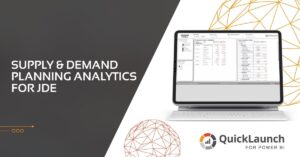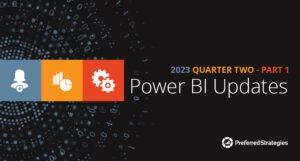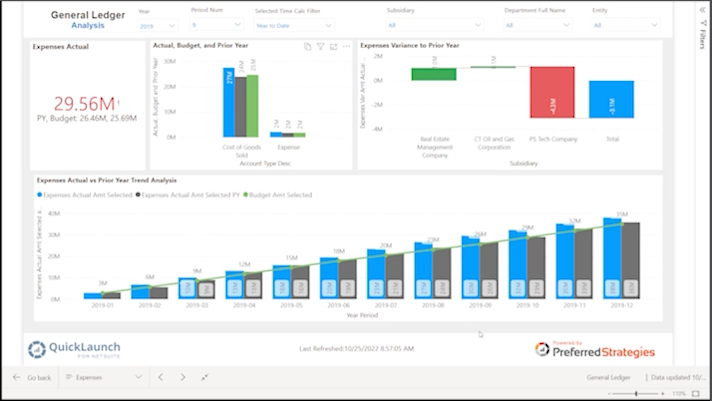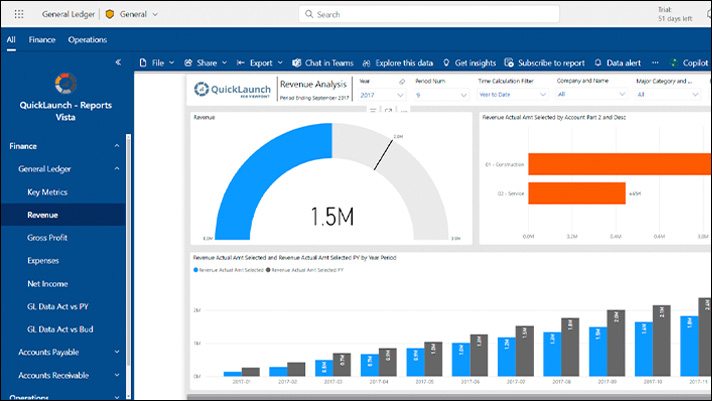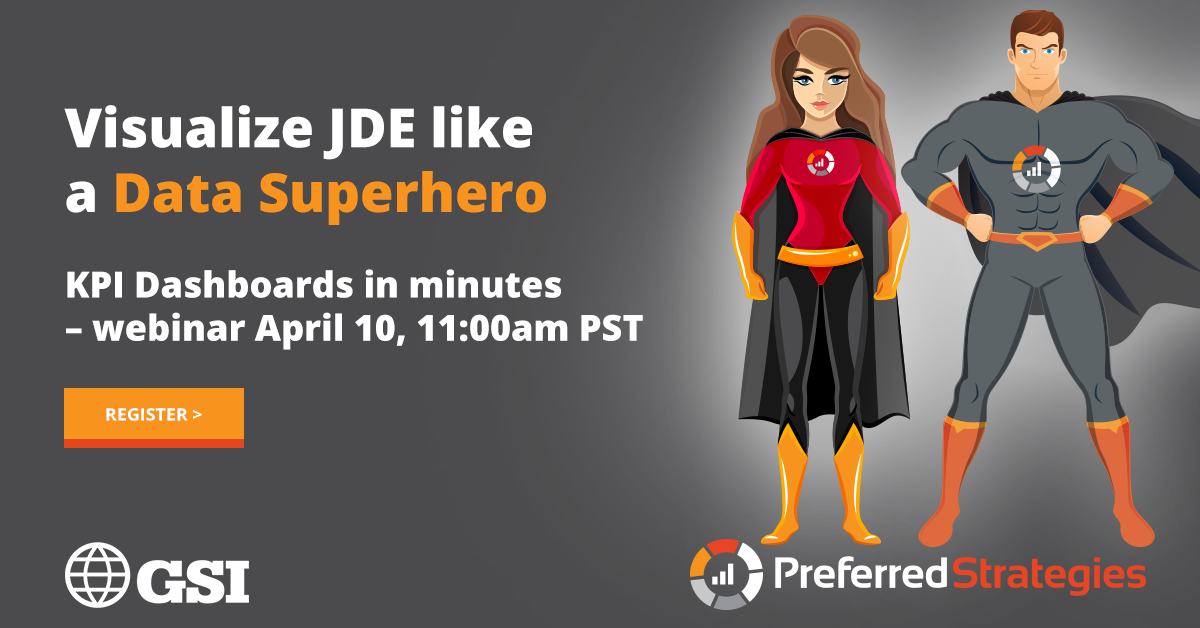
We co-hosted a webinar with GSI which had an outstanding attendance. There were many excellent questions and we were not able to provide answers to all of them during the webinar. Here is the Q&A transcript.
Q. Do you have models created for the JDE Configurator (System 32?)
A. We do not currently have JDE Configurator (System 32) as an out-of-box module with QuickLaunch. Once your requirements related to JDE Configurator are identified, we can provide feedback and proposal on the effort to include this or determine where this fits on the QuickLaunch development roadmap.
Q. What is the difference in the QuickLaunch software vs the out of the box Power BI?
A. QuickLaunch translates the JDE data so that your Power BI visualizations make sense. Without QuickLaunch you’re left writing the glossary translation, your users have to know things like Table F0101 is actually the address book.
Here are some other key points:
- Supports all the major JDE modules
- Translates complex JDE aliases into business-friendly names
- Dozens of pre-built reports & templates to deliver faster business insights
- Integrated data governance including calculated measures and KPI’s
- Easily solves complex calculations such as aging and calendar-based events
- Integrate other data sources with your JDE data
- Simple deployment options-on premise, cloud or hybrid hosting
Q. Has Microsoft Power BI replaced the Business Objects BI software that was used few years back?
A. Short answer yes, in many companies. Power BI is a new classification of BI software that Gartner calls modern BI. The difference being that traditionally IT would use a tool like BusinessObjects to create reports upon request from the business, modern BI tools are designed to hide the complexity of these legacy tools to help business users gain the insights themselves without relying on IT. This not only shortens the time to value, it alleviates a constant interrupt driven operational process in IT.
Q. Can you please talk about the pricing of the tool and also if all of the JDE data is accessed real-time?
A. We offer various pricing options from subscription to perpetual license. The fees structure changes by the number of JDE modules being used with QuickLaunch and the connection method to your data (Direct Connect, Operational Data Store, Data Warehouse). We support 14 modules of JD Edwards out-of-box with QuickLaunch, so we are not pulling all JDE data into QuickLaunch, however, any data required for reporting and analytics with QuickLaunch can be added very quickly. Typically, customers will refresh their QuickLaunch Analysis Services Tabular Model/Cube on an hourly schedule, however, we have alternative ways customers can update it within a matter of minutes and be executed on demand, i.e. the Controller in month-end close can kick off a financial refresh of data and have JDE GL information loaded in the data model within a couple minutes. Our QuickLaunch Enterprise Data Warehouse (EDW) is updated within 5-10 minutes of JDE transaction data and we are currently rolling out a Direct Query Tabular Model over the EDW so once data is in EDW it can be read directly by Power BI.
Q. What versions of JDE are supported?
A. We support all versions of JD Edwards World and EnterpriseOne
Q. Can cube data be combined with other independent data-files within Power BI?
A. Yes, data can be imported into a Power BI report from a Tabular Data Model/Cube and related to other data sources. If a Power BI report is developed from a Tabular Cube in a “direct live” option, then it cannot be related to other data sources.
Q. What needs to be done to publish a dashboard within Sharepoint to make sure everyone can access/see the visuals?
A. QuickLaunch customers typically share Power BI reports via the Power BI Service (in the cloud) or on premise with the Power BI Report Server but if you want some information regarding Power BI with SharePoint, the information below may help, as well as looking at sharepoint permissions management.
The way the feature works is simple. Follow the process below to use this feature.
1) Publish your Power BI report to your Power BI account
2) Get the URL to the report
3) Add the Power BI (preview) web part to your SharePoint Online page
4) Paste the URL of the report when prompted
5) To finish, save and publish your page!
Some other URL’s to explore are below as well.
https://www.sharepointeurope.com/integrate-power-bi-reports-in-sharepoint-online/
http://www.axioworks.com/2018/02/using-power-bi-with-sharepoint-data-the-ultimate-guide/
Q. Is there a limit to the number of columns and rows in a table/ visualization and number of filters on one report?
A. None. Bring it on!
Q. The templates for security module are included ?
A. We do not have a module specifically for JDE Security, but we do configure our Tabular Model to reflect JD Edwards row security when that is required by the customer. Since we are already connecting to the JDE security tables it would be an easy addition if a customer would like to build reports over the JDE Security information.
Q. How do you handle fields that have been repurposed or User Reserved Fields as well?
A. Part of the QuickLaunch out-of-box configuration includes the renaming of JD Edwards Category Codes so if your BU Code 01 is Region, it will be labeled as Region instead of BU Code 01 or MCRP01. We also support Custom Tables, Tag Files, and other data outside JDE can be added to a QuickLaunch data model.
Q. Which version of PowerBI it used? what is architectural schema/ requirements for deployment?
A. Microsoft has an aggressive upgrade program with Power BI and we ensure that QuickLaunch works with each version. There are a number of ways to deploy QuickLaunch with PowerBI and this is dependent on your on-prem verses cloud deployment decisions. We work equally well in either environment or a hybrid which is becoming more common today, whereby JDE data is still operationalized on premises and data for Analytics, reporting and data science is mirrored on to a data lake or a cloud based data warehouse. Power BI in itself (Power BI Desktop and Cloud Service) doesn’t have many requirements to get going other than setting up a Gateway connection to connect your reports in the cloud to your data on-premise, but to implement Power BI as and Enterprise solution we recommend using our SQL Server Analysis Services (SSAS) Tabular Mode to manage datasets on a BI server which becomes the governed source of truth for Power BI. There are some differences between SQL Server Enterprise and Standard Edition (Perspectives, Partitioning, and Instance sizes, etc.). Our QuickLaunch SSAS Data Model utilizes best practices and is the most optimized and affordable way to get Power BI running over JDE.
Q. How do you implement near real-time updates for your data warehouse product?
A. If you are running JD Edwards on SQL Server, we have developed QuickLaunch SQL Server Integration Services (SSIS) ETL Packages using incremental methodologies (Native CDC or Change Tracking) which run every 5 minutes or so to extract data from the JDE SQL DB transaction logs and update the changes in the EDW. Typically our EDW runs around with about a 10 minute lag behind JDE data. If you are running JD Edwards on iSeries or Oracle, we use third party replication software to mirror JDE data into an Operational Data Store (ODS) on SQL Server ever few minutes and then we run our QuickLaunch SQL (ODS) to SQL (EDW) SSIS ETL scripts to update the EDW. If you are unfamiliar with the role of SQL, you can look at blog posts from Timescale that delve into this area and can provide more background.
Q. We have a number of custom tables in our instance of JDE, can QuickLaunch support those?
A. Yes, we support custom tables. We can add them as part of the initial rollout, but we also provide knowledge transfer to you so you can do it yourself in the future as well. Once the Custom Tables are added to the model and related properly to the other data in the model, it will be exposed to PowerBI for Analytics and Reporting.
Q. How do I know the data I am using with QuickLaunch is trusted?
A. Great question and critical for deploying a self-service data environment. If IT is not preparing the reports, there may be natural skepticism around the results a business user is generating and displaying with PowerBI. This is where QuickLaunch can help, by connecting to your source JDE data and translating the obscure table and field terms into comprehensible business glossaries, this will provide the assurance that the right data is being selected for analysis. Other complex calculations such as KPI’s and measures, calendering, calculated values are all handled by QuickLaunch leaving nothing to chance or interpretation. When asked “where did you get this data?” the response is QuickLaunch on JDE so it is considered trusted by IT and across the org. We also document the lineage of each field in the Data Model back the source JDE field so people know where the data has originated from.
Q. Are we going to get a copy of the slides or do we need to screenshot each slide…?
A. Please find a link to the slides here




